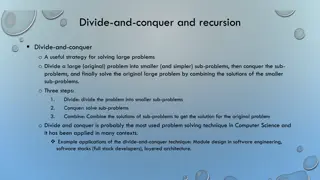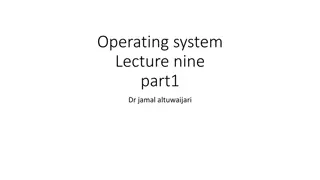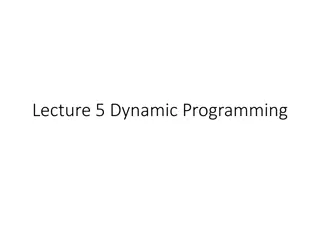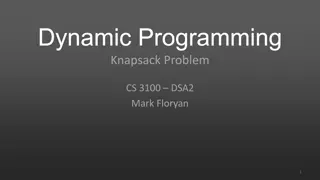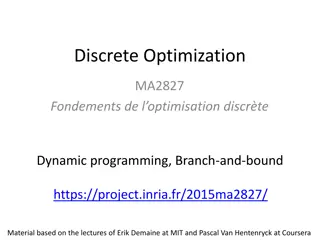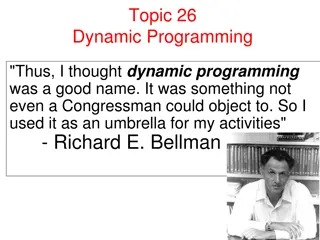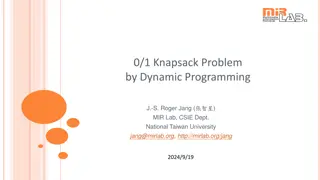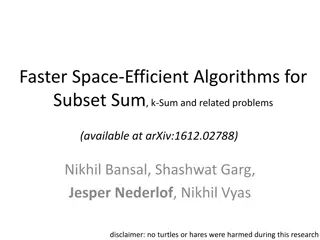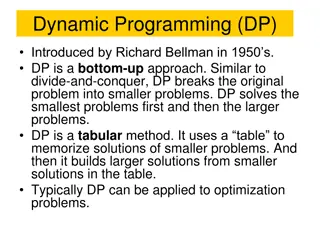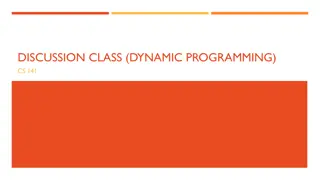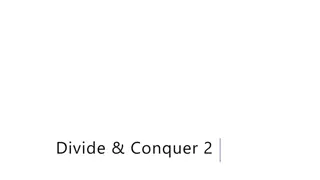Solving Maximum Contiguous Subarray Sum Problem with Dynamic Programming
Explore the concept of finding the maximum contiguous subarray sum using dynamic programming as an improvement over divide and conquer algorithms. Learn the steps of defining the objective, writing recurrences, designing memoization structures, and implementing iterative algorithms. Delve into the decision-making process for optimizing subarray sum calculations and understand the recursive values required for efficient computation.
Download Presentation

Please find below an Image/Link to download the presentation.
The content on the website is provided AS IS for your information and personal use only. It may not be sold, licensed, or shared on other websites without obtaining consent from the author.If you encounter any issues during the download, it is possible that the publisher has removed the file from their server.
You are allowed to download the files provided on this website for personal or commercial use, subject to the condition that they are used lawfully. All files are the property of their respective owners.
The content on the website is provided AS IS for your information and personal use only. It may not be sold, licensed, or shared on other websites without obtaining consent from the author.
E N D
Presentation Transcript
Even More DP CSE 421 Fall 22 Lecture 14
Maximum Contiguous Subarray Sum We saw an ?(?log?) divide and conquer algorithm. Can we do better with DP? Given: Array ?[] Output: ?,? such that ? ? + ? ? + 1 + + ?[?] is maximized.
Dynamic Programming Process 1. Define the object you re looking for 2. Write a recurrence to say how to find it 3. Design a memoization structure 4. Write an iterative algorithm
Maximum Contiguous Subarray Sum We saw an ?(?log?) divide and conquer algorithm. Can we do better with DP? Given: Array ?[] Output: ?,? such that ? ? + ? ? + 1 + + ?[?] is maximized. For today: just output the value? ? + ? ? + 1 + + ?[?]. State what you want OPT(i) to be in English, is that enough to do the recursion?
Trying to Recurse 0 0 5 1 1 -6 2 2 3 3 3 4 4 4 -5 5 5 2 6 6 2 7 7 4 ??? 3 would give ? =2, ? = 3 ???(4) would give ? = 2,? = 3 too ???(7) would give ? = 2,? = 7 we need to suddenly backfill with a bunch of elements that weren t optimal How do we make a decision on index 7? What information do we need?
What do we need for recursion? If index ? IS going to be included We need the best subarray that includes index that includes index ? ? If we include anything to the left, we ll definitely include index ? 1 (because of the contiguous requirement) If index ?isn t included We need the best subarray up to ? 1, regardless of whether ? 1 is included.
Two Values Pollev.com/robbie Need two recursive values: ???????(?): sum of the maximum sum subarray among elements from 0 to ? that includes index that includes index ? in the sum ???(?): sum of the maximum sum subarray among elements 0 to ? (that might or might not include ?) How can you calculate these values? Try to write recurrence(s), then think about memoization and running time.
Recurrences max ? ? ,? ? + ??????? ? 1 if ? 0 otherwise ??????? ? = 0 ??? ? = max ??????? ? ,??? ? 1 if ? 0 0 otherwise If we include ?, the subarray must be either just ? or also include ? 1. Overall, we might or might not include ?. If we don t include ?, we only have access to elements ? 1 and before. If we do, we want ???????(?) by definition.
Example 0 0 5 1 1 2 2 3 3 3 4 4 4 -5 5 5 2 6 6 2 7 7 4 ? -6 0 0 5 1 1 2 2 3 3 4 4 5 5 6 6 7 7 ???(?) 0 0 5 1 1 2 2 3 3 4 4 5 5 6 6 7 7 ???????(?)
Example 0 0 5 1 1 2 2 3 3 3 4 4 4 -5 5 5 2 6 6 2 7 7 4 ? -6 0 0 5 1 1 5 2 2 3 3 4 4 5 5 6 6 7 7 ???(?) 0 0 5 1 1 -1 2 2 3 3 4 4 5 5 6 6 7 7 ???????(?)
Example 0 0 5 1 1 2 2 3 3 3 4 4 4 -5 5 5 2 6 6 2 7 7 4 ? -6 0 0 5 1 1 5 2 2 5 3 3 7 4 4 7 5 5 7 6 6 7 7 7 10 ???(?) 0 0 5 1 1 -1 2 2 3 3 3 7 4 4 2 5 5 4 6 6 6 7 7 10 ???????(?)
Pseudocode int maxSubarraySum(int[] A) int n=A.length int[] OPT = new int[n] int[] Inc = new int[n] inc[0]=A[0]; OPT[0] = max{A[0],0} for(int i=0;i<n;i++) inc[i]=max{A[i], A[i]+inc[i-1]} OPT[i]=max{inc[i], opt[i-1]} endFor return OPT[n-1]
Recursive Thinking In General As before, the hardest part is designing the recurrence. It sometimes helps to think from multiple different angles. Top Top- -down: down: What s the first step to take? Baby Yoda will first go left or down. Use recursion to find out which of left or down is better. The farthest right operation in the string transformation will be one of insert, delete, substitute, match for free. Use recursion to find out which is best.
Recursive Thinking In General Bottom Bottom- -Up: help? How does a path through most of the map help Baby Yoda? Well we just need to know the values one left and one down. The edit distance between which strings would help us compute the edit distance between our strings? Well if we know the distance between ?1 ?? 1 and ?1 ?? 1 then that would tell us what happens if we substitute that might lead you to insertions and deletions too. Up: What information could a recursive call give me that would
Recursive Thinking In General Some people refer to the Optimal Substructure Property From the optimum (most eggs, fewest number of string operations) for a slightly smaller problem (Baby Yoda starting closer to the end, slightly smaller strings), we need to be able to build up the optimum for the full problem.
Longest Increasing Subsequence 0 5 1 2 3 3 6 4 5 2 6 8 7 -6 -5 10 Longest set of (not necessarily consecutive) elements that are increasing 5 is optimal for the array above (indices 1,2,3,6,7; elements 6,3,6,8,10) For simplicity assume all array elements are distinct.
Longest Increasing Subsequence What do we need to know to decide on element ?? Is it allowed? Will the sequence still be increasing if it s included? Still thinking right to left -- Two indices: index we re looking at, and index of upper bound on elements (i.e. the value we need to decide if we re still increasing).
Recurrence 0 5 1 2 3 3 6 4 5 2 6 8 7 -6 -5 10 Recursive call is best value in this area Current ? Ignored for now. Need recursive answer to the left Currently processing ? Recursive calls to the left are needed to know optimum from 1 ? Will move ? to the right in our iterative algorithm
Longest Increasing Subsequence ??? ?,?is Number of elements of the maximum increasing subsequence from 0, ,? where every element of the sequence is at most ?[?] Need a recurrence ? ? ? ? if ? < 0 if ? = 0 ??? ?,? = if ? ? > ? ? otherwise
Longest Increasing Subsequence ??? ?,?is Number of elements of the maximum increasing subsequence from 0, ,? where every element of the sequence is at most ?[?] Need a recurrence ? ? ? ? if ? < 0 if ? = 0 ??? ?,? = if ? ? > ? ? otherwise If ? ? > ?[?] element ? cannot be included in an increasing subsequence where every element is at most ?[?]. So taking the largest among the first ? 1 suffices. If ? ? ?[?], then if we include ?, we may include elements to the left only if they are less than ?[?] (since ? ? will now be the last, and therefore largest, of elements 1 ?. If we don t include ? we want the maximum increasing subsequence among 1 ? 1.
Longest Increasing Subsequence ??? ?,?is Number of elements of the maximum increasing subsequence from 0, ,? where every element of the sequence is at most ?[?] Need a recurrence 0 ?[? ? ? ? ] ??? ? 1,? max 1 + ??? ? 1,? ,??? ? 1,? If ? ? > ?[?] element ? cannot be included in an increasing subsequence where every element is at most ?[?]. So taking the largest among the first ? 1 suffices. If ? ? ?[?], then if we include ?, we may include elements to the left only if they are less than ?[?] (since ? ? will now be the last, and therefore largest, of elements 0 ?. If we don t include ? we want the maximum increasing subsequence among 0 ? 1. if ? < 0 if ? = 0 ??? ?,? = if ? ? > ? ? otherwise
Longest Increasing Subsequence 0 ?[? ? ? ? ] ??? ? 1,? max 1 + ??? ? 1,? ,??? ? 1,? if ? < 0 if ? = 0 ??? ?,? = if ? ? > ? ? otherwise Memoization structure? ? ? array. Filling order?
0 ?[? ? ? ? ] ??? ? 1,? max 1 + ??? ? 1,? ,??? ? 1,? if ? < 0 if ? = 0 LIS ??? ?,? = if ? ? > ? ? otherwise ? 0, 0, 5 1, 1, 6 2, 2, 3 3, 3, 6 4, 4, 5 5, 5, 2 6, 6, 8 7, 7,10 0, 0, 5 6 3 6 5 2 8 1, 1, 2, 2, 3, 3, ? 4, 4, 5, 5, 6, 6, 7, 7,10
0 ?[? ? ? ? ] ??? ? 1,? max 1 + ??? ? 1,? ,??? ? 1,? if ? < 0 if ? = 0 ??? 1,0? 1 < ?[0] not allowed: Take ???(0,0) LIS ??? ?,? = if ? ? > ? ? otherwise ? 0, 0, 5 1 1 1, 1, 6 0 2, 2, 3 0 3, 3, 6 1 4, 4, 5 0 5, 5, 2 0 6, 6, 8 1 7, 7,10 1 0, 0, 5 6 3 6 5 2 8 1, 1, 2, 2, 3, 3, ? 4, 4, 5, 5, 6, 6, 7, 7,10
??? 1,1? 1 ?[1] can add, 1 + ???(0,1) or ???(0,1) 0 ?[? ? ? ? ] ??? ? 1,? max 1 + ??? ? 1,? ,??? ? 1,? if ? < 0 if ? = 0 LIS ??? ?,? = if ? ? > ? ? otherwise ? 0, 0, 5 1 1 1, 1, 6 0 1 2, 2, 3 0 3, 3, 6 1 4, 4, 5 0 5, 5, 2 0 6, 6, 8 1 7, 7,10 1 0, 0, 5 6 3 6 5 2 8 1, 1, 2, 2, 3, 3, ? 4, 4, 5, 5, 6, 6, 7, 7,10
0 ?[? ? ? ? ] ??? ? 1,? max 1 + ??? ? 1,? ,??? ? 1,? if ? < 0 if ? = 0 ??? 1,2? 1 ?[2] allowed to add: 1 + ??? 0,1 or ???(0,2) LIS ??? ?,? = if ? ? > ? ? otherwise ? 0, 0, 5 1 1 1, 1, 6 0 1 2, 2, 3 0 1 3, 3, 6 1 4, 4, 5 0 5, 5, 2 0 6, 6, 8 1 7, 7,10 1 0, 0, 5 6 3 6 5 2 8 1, 1, 2, 2, 3, 3, ? 4, 4, 5, 5, 6, 6, 7, 7,10
0 ?[? ? ? ? ] ??? ? 1,? max 1 + ??? ? 1,? ,??? ? 1,? if ? < 0 if ? = 0 ??? 2,0? 2 ? 0 allowed to add 1 + ???(1,2) or ???(1,0) LIS ??? ?,? = if ? ? > ? ? otherwise ? 0, 0, 5 1 1 2 1, 1, 6 0 1 2, 2, 3 0 1 3, 3, 6 1 1 4, 4, 5 0 1 5, 5, 2 0 1 6, 6, 8 1 1 7, 7,10 1 1 0, 0, 5 6 3 6 5 2 8 1, 1, 2, 2, 3, 3, ? 4, 4, 5, 5, 6, 6, 7, 7,10
0 ?[? ? ? ? ] ??? ? 1,? max 1 + ??? ? 1,? ,??? ? 1,? if ? < 0 if ? = 0 LIS ??? ?,? = if ? ? > ? ? otherwise ? 0, 0, 5 1 1 2 2 1, 1, 6 0 1 1 1 1 1 1 1 2, 2, 3 0 1 2 2 2 3 3 3 3, 3, 6 1 1 2 3 3 3 3 3 4, 4, 5 0 1 1 1 2 2 2 2 5, 5, 2 0 1 1 1 2 3 3 3 6, 6, 8 1 1 2 3 3 3 4 4 7, 7,10 1 1 2 3 3 3 4 5 0, 0, 5 6 3 6 5 2 2 8 1, 1, 2, 2, 3, 3, ? 4, 4, 5, 5, 3 3 3 6, 6, 7, 7,10
pseudocode //real code snippet that actually generated the table on the last slide for(int j=0; j < n; j++){ vals[0][j] = (A[0] <= A[j]) ? 1 : 0; } for(int i = 1; i < 8; i++){ for(int j = 0; j < n; j++){ if(A[i] > A[j]) vals[i][j] = vals[i-1][j]; else{ vals[i][j] = Math.max(1+vals[i-1][i], vals[i-1][j]); } } }
Longest Increasing Subsequence 0 ?[? ? ? ? ] ??? ? 1,? max 1 + ??? ? 1,? ,??? ? 1,? if ? < 0 if ? = 0 ??? ?,? = if ? ? > ? ? otherwise Memoization structure? ? ? array. Filling order? Outer loop: increasing ? Inner loop: increasing ?
LIS One more thing .what s the final answer? We want the longest increasing sequence in the whole array. ??? ?,?is Number of elements of the maximum increasing subsequence from 0, ,? where every element of the sequence is at most ?[?] What do we want?
LIS One more thing .what s the final answer? We want the longest increasing sequence in the whole array. ??? ?,?is Number of elements of the maximum increasing subsequence from 0, ,? where every element of the sequence is at most ?[?] ???(?,?). Intuitively, ?represents the last element in the array. max ? Anything could be the last one! Take the maximum.







